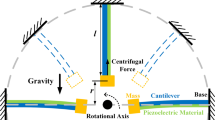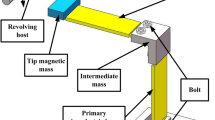Abstract
Energy harvesting from rotational motion has drawn attention over the years to energise low-power wireless sensor networks in a rotating environment. The harvester works efficiently in a small frequency range which has to be similar to the driving frequency. Because of the constraints of size, precision, and the energy harvester’s weight, it is challenging to design it to suit micro applications. To deal with this problem, this paper proposes a rotational piezoelectric energy harvester (RPEH), which generates a voltage output from rotational motion. This design increases the gravitational force acting on the system by increasing the length of the beam, which in turn increases its vibration in a transverse direction. Euler-Bernoulli’s theory is utilized to derive the mathematical model of the RPEH under rotational motion, and harvester dynamic equations are derived using the electromechanical Lagrange equations. A prototype of RPEH is developed and the exactness of the proposed mathematical model is verified using experimental results and numerical simulation. Maximum power of 43.77 uW is produced at a rotating frequency of 21 Hz (1260 rpm) with an optimum load resistance of 1141.3 kΩ.
Similar content being viewed by others
Abbreviations
- B(x,t):
-
Internal bending moment
- wi(x,t):
-
Transverse displacement of the ith mode
- c :
-
Variable damping coefficient
- m :
-
Mass per unit length
- f(x,t):
-
Forcing function
- E :
-
Elastic modulus
- I :
-
Moment of inertia
- a i :
-
Coupling term
- v(t):
-
Voltage across the piezoelectric patch
- ϕi(x):
-
Eigen function of the beam
- ηi(t):
-
Time-varying generalized coordinates
- EI :
-
Bending stiffness
- E b :
-
Beam Young’s modulus
- W b :
-
Beam width
- ρ b :
-
Beam density
- t b :
-
Beam thickness
- E p :
-
Piezo Young’s modulus
- W p :
-
Piezo width
- ρ p :
-
Piezo density
- t p :
-
Piezo thickness
- L p :
-
Piezo length
- h a :
-
Distance from the neutral axis to the bottom of the substrate
- h b :
-
Distance from the neutral axis to the bottom ofthe piezoelectric layer
- h c :
-
Distance from the neutral axis to the top of the piezoelectric layer
- h pc :
-
Distance from the neutral axis and the center of the piezoelectric layer
- m t :
-
Tip mass
- J t :
-
Tip mass moment of inertia
- d :
-
Distance between the active length of the beam to the centre of gravity of the tip mass
- ω bi :
-
Natural frequency of the beam
- λ i :
-
Dimensionless frequency parameter
- J b :
-
Beam inertia
- θ :
-
Angular displacement of the system
- \(\dot \theta \) :
-
Driving frequency
- g :
-
Acceleration due to gravity
- w ie :
-
Internal electrical energy in the piezoelectric layer
- e 31 :
-
Piezoelectric constant
- C p :
-
Piezoelectric capacitance
- ε 33 s :
-
Dielectric constant
- T :
-
Total kinetic energy of the system
- U :
-
Total potential energy of the system
- Q :
-
Electric charge output of the piezoelectric layer
- M eq :
-
Equivalent mass
- C eq :
-
Damping
- K eq :
-
Equivalent stiffness
- k gi :
-
Geometric stiffness
- ζ i :
-
Mechanical damping ratio
- B :
-
Modal excitation produced by rotation
- ω i :
-
Resonant frequency of the beam
- F i :
-
Amplitude of the modal mechanical forcing function
- H i :
-
Amplitude of modal coordinate function
- V :
-
Amplitude of voltage
- R :
-
Load resistance
- β i :
-
Coupling term
- j :
-
Unit imaginary number
- V oc :
-
Open-circuit voltage
- P :
-
Harvested power
- R opt :
-
Optimum resistance
References
P. Asghari et al., Internet of things applications: a systematic review, Comput. Networks, 148 (2019) 241–261.
L. Manoel, Wireless sensor network for monitoring environmental factors in industrial installations, 2015 CHILEAN Conference on Electrical, Electronics Engineering, Information and Communication Technologies (CHILECON) (2015) 707–710.
A. Nechibvute, A. Chawanda and P. Luhanga, Piezoelectric energy harvesting devices: an alternative energy source for wireless sensors, Smart Mater. Res., 2012 (2012).
X. Tang et al., Energy harvesting technologies for achieving self-powered wireless sensor networks in machine condition monitoring: a review, Sensors, 18 (2018) 4113.
B. P. D. Mitcheson et al., Energy harvesting from human and machine motion for wireless electronic devices, Proc. of the IEEE, 96(9) (2008) 1457–1486.
S. Roundy, P. K. Wright and J. Rabaey, A study of low-level vibrations as a power source for wireless sensor nodes, Computer Communications, 26 (2003) 1131–1144.
C. R. Bowen and M. H. Arafa, Energy harvesting technologies for tire pressure monitoring systems, Advanced Energy Materials (2014) 1–17.
J. Zhang, Z. Fang, C. Shu, J. Zhang, Q. Zhang and C. Li, A rotational piezoelectric energy harvester for efficient wind energy harvesting, Sensors Actuators, A Phys., 262 (2017) 123–129.
H. Huang and K. Chen, Design, analysis, and experimental studies of a novel PVDF-based piezoelectric energy harvester with beating mechanisms, Sensors Actuators A. Phys., 238 (2016) 317–328.
H. Jung, Y. Song, S. Kwang, C. Ho, S. Joo, S. Yeong and T. Hyun, Design and optimization of piezoelectric impact-based micro wind energy harvester for wireless sensor network, Sensors Actuators A. Phys., 222 (2015) 314–321.
R. Lockhart, P. Janphuang, D. Briand and N. F. De Rooij, A wearable system of micro machined piezoelectric cantilevers coupled to a rotational oscillating mass for on-body energy harvesting, Proc. IEEE Int. Conf. Micro Electro Mech. Syst. (2014) 370–373.
L. Gu and C. Livermore, Compact passively self-tuning energy harvesting for rotating applications, Smart Mater. Struct., 21 (2012).
M. Guan and W.-H. Liao, Design and analysis of a piezoelectric energy harvester for rotational motion system, Energy Convers. Manag, 111 (2016) 239–244.
F. Khameneifar, M. Moallem and S. Arzanpour, Modeling and analysis of a piezoelectric energy scavenger for rotary motion applications, J. Vib. Acoust., 133 (2011) 011005.
F. Khameneifar, S. Arzanpour and M. Moallem, A piezoelectric energy harvester for rotary motion applications: design and experiments, IEEE/ASME Trans. Mechatronics, 18 (2013) 1527–1534.
A. Erturk and D. J. Inman, A distributed parameter electromechanical model for cantilevered piezoelectric energy harvesters, J. Vib. Acoust, 130(1) (2008) 15.
R. Usharani et al., Design of high output broadband piezoelectric energy harvester, J. Mech. Sci. Technol., 31(7) (2017) 3131–3142.
R. Usharani, G. Uma, M. Umapathy and S. Choi, A new piezoelectric-patched cantilever beam with a step section for high performance of energy harvesting, Sensors Actuators A. Phys., 265 (2017) 47–61.
W.-J. Su, Design and development of multi-directional dual-beam piezoelectric energy harvesters, Ph.D. Thesis, University of Toronto (2014).
S. S. Raju, M. Umapathy and G. Uma, Cantilever piezoelectric energy harvester with multiple cavities, Smart Mater. Struct., 24 (2015) 115023.
A. Erturk and D. J. Inman, Piezoelectric Energy Harvesting, John Wiley & Sons, USA (2011).
S. Priya and D. J. Inman, Energy Harvesting Technologies, Springer, USA (2009).
D. J. Inman, Engineering Vibration, 3rd Edition, Prentice Hall (2007).
M. Zhu, E. Worthington and A. Tiwari, Design study of piezoelectric energy-harvesting devices for generation of higher electrical power using a coupled piezoelectric-circuit finite element method, IEEE Trans. Ultrason. Ferroelectr. Freq. Control, 57 (2010) 427–437.
Q. Zhao, Y. Liu, L. Wang, H. Yang and D. Cao, Design method for piezoelectric cantilever beam structure under low frequency condition, Int. J. Pavement Res. Technol., 11(2) (2017) 153–159.
Z. Yu, C. Y. Zhang and S. Y. Zhang, Simulation analysis and optimization design for wide band piezoelectric oscillator of energy harvesting device, J. Mech. Sci. Technol., 34(7) (2020) 2745–2750.
W. G. Li, S. He and S. Yu, Improving power density of a cantilever piezoelectric power harvester through a curved L-shaped proof mass, IEEE Trans. Ind. Electron., 57(3) (2010) 868–876.
ANSYS, Mechanical APDL Coupled-Field Analysis Guide, ANSYS Release 19.0 Documentation (2013).
Acknowledgments
The authors would like to acknowledge the support from DRDO, Government of India.
Author information
Authors and Affiliations
Corresponding author
Additional information
V. Raja completed his Bachelor’s degree in Mechanical Engineering from Saranathan College of Engineering, Tiruchirappalli, India. He completed his Master’s degree in Engineering Design from PSG college of Technology, Coimbatore, India. He is currently a Research Scholar in the Department of Instrumentation and Control Engineering at the National Institute of Technology, Tiruchirappalli, India. He worked as senior research fellow in ARDE-DRDO Pune, Government of India sponsored project. His research interest includes rotation based piezoelectric energy harvesting with a storage system.
M. Umapathy is a Professor in the Department of Instrumentation and Control Engineering, at NIT, Trichy. He received his B.E. from GCT, Coimbatore, M.Tech. from IIT, Madras and Ph.D. from IIT, Bombay. His research interests include instrumentation systems, energy harvesting, MEMS and smart structures.
G. Uma is a Professor in the Department of Instrumentation and Control Engineering, NIT, Trichy. She received her B.E. from GCT, Coimbatore, M.E. from M.I.T, Chennai and Ph.D. from NIT, Trichy. Her research interests include design and development of instrumentation systems, energy harvesting, MEMS and process control. She received a Young Scientist Fellowship from Tamil Nadu State Council for Science and Technology under which she worked in the Thin Film Laboratory, Department of Instrumentation at the Indian Institute of Science Bangalore.
B. Praveen Kumar is a scientist working in the Centre for Piezoelectric Materials at ARDE-DRDO Pune. He has been working the past 17 years, in the field of processing and characterization of various Piezo materials and their related devices at DRDO. His current research interests are advance functional materials, porous ceramics, pulse power generators, coatings and sensor devices. He completed his B.E. from NIT Trichy and Ph.D. from IIT Madras in the field of sensor materials and devices. He has published 38 papers in peer-reviewed journals and 18 papers in conference proceedings. He has been awarded the DRDO Young Scientist Award, DRDO Technology Group Award and the Young Alumni Award by NIT Trichy.
S. Premkumar is working as a Scientist — E in the Armament Research and Development Establishment (ARDE) at Defence Research and Development Organisation (DRDO) Pune, India. He did his B.Sc. (Physics) at the Chikkaiah Naicker College, Erode, M.Sc. (Materials Science) from PSG College of Technology, Coimbatore and M.E. (Materials Science) from National Institute of Technology, Tiruchirappalli. His areas of research include development of Piezoelectric materials and devices, development of miniaturized 2–2 layered magnetoelectric composites and DFT study of lead and lead-free perovskite structures.
Rights and permissions
About this article
Cite this article
Raja, V., Umapathy, M., Uma, G. et al. Design, analysis and experimental investigation of a rotational piezoelectric energy harvester with storage system. J Mech Sci Technol 34, 4475–4487 (2020). https://doi.org/10.1007/s12206-020-1008-4
Received:
Revised:
Accepted:
Published:
Issue Date:
DOI: https://doi.org/10.1007/s12206-020-1008-4




